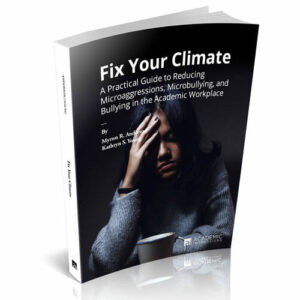
With faculty and students both stressed during the pandemic, microaggressions may become more frequent in our online learning environment. Here are some practical strategies for mitigating the impact of microaggressions in online and remote classes.
by Dr. Tasha Souza, Associate Director for Inclusive Excellence for the Center for Teaching and Learning, Professor of Communication, Boise State University
Students are especially anxious right now given that their daily routine and expectations of college life have likely been completely derailed. Many have had to move, some to less safe and/or hospitable living environments, and all who were taking face-to-face classes have had to learn how to navigate a different learning and teaching space led by many instructors doing the same. When cortisol levels are high, we are less likely to self-monitor well and more likely to behave in ways that reveal and act upon our implicit biases. These biases can show up as written or oral microaggressions in online and remote spaces and can have a negative effect on the communication climate. Are you equipped to deal with them? When microaggressions occur in our learning environments, it is important that we respond in ways that maintain a supportive communication climate (Souza, 2017) and foster learning.
Before considering communication strategies for responding in the moment, it is important to reflect upon ways to mitigate the impact of microaggressions:
First, consider the risks you are asking students to take in participating, especially at this particular time. When students contribute to an online discussion or a remote, synchronous session, they may worry that their contributions may be unpopular, expose a lack of knowledge, and/or make them vulnerable to harsh judgments by their peers and/or instructor. Remote speaking, especially if recorded, will feel similar to public speaking (which can be especially anxiety-producing) given the unfamiliar and seemingly permanent nature of such expression. All of these fears will feel confounded by the trauma of dealing with a global pandemic and the uncertainty, insecurity, and anxiety that accompanies it.
Second, recognize that some students will feel more at ease than others in interacting online and consider how you will try to create some balance with contributions. Stereotype threat (Steele, 2010) will play a role in students’ decisions to participate so you may be left with students who have the most dominant identities and the greatest privilege being the ones who contribute the most (Souza, Vizenor, Sherlip, & Raser, 2016). Negative experiences with online harassment due to targeted identities can also increase anxiety for students. Four in ten U.S. Americans have experienced online harassment and more than 25% have chosen to not post something online after seeing harassment of others (Duggan, 2017).
Given substantial evidence on the importance of interaction in online spaces and the psychological burden our students are currently facing, we must be especially thoughtful and intentional regarding such interactions. It is important to communicate in both implicit and explicit ways that you authentically care not only about your students’ learning but about their well-being. Perceived teacher caring is “associated with increased affective and perceived cognitive learning” (Teven & McCrosky, 1996, p. 8). Research by Phelan, Davidson, and Cao (1992) suggests that students are more motivated to learn when they have caring instructors. Share self-care resources with them, do regular check-ins, and gather feedback from them on how they are doing and what challenges they are facing that are impacting their learning. And help students understand that their contributions are an important part of the community learning process.
Further, it’s never too late to co-construct group/community agreements to hold each other accountable to certain ways of engaging (Noah & Souza, 2018). Creating the group agreements together (e.g., in Google Docs) can draw attention to the importance of language choice. For example, a student may suggest creating a “safe space” which can allow you to discuss/share that this space may not ever feel safe for all students no matter how supportive the communication climate. You can ask them to consider using “brave space” instead to recognize that participation takes courage and that it feels differently based on our identities. Be sure to revisit, reflect upon, and refine group agreements periodically. These will inevitably need to change to respond to your particular students’ needs and the evolving pandemic.
The group agreements can be referenced when a microaggression occurs. For example, “be thoughtful and humble about language choice” can be a helpful group agreement to have in place when a student uses a term that is offensive. As instructors, it is our responsibility to respond to microaggressions in our instructional spaces as no response suggests complicity. It is best to do so in a way that calls a student in, which is done with more compassion, grace, and patience, versus calling them out. Although there are various communication tools (e.g., Rosenberg, 2003) that can organize one’s thoughts when attempting to call in, I will describe one that I find especially useful and easy to remember for developing a response. This tool is called OTFD, which stands for Open the Front Door (OTFD) to communication (Learning Forum, 2016; Souza, 2016). The phrase “open the front door” is a mnemonic for the four steps of this tool that follow:
Observe: State in clear, unambiguous language what occurred. Seek common ground here by stating an observation without judgment so that all involved could agree on the speech act, behavior, or incident.
Think: Express what you think and/or what you imagine others might be thinking based on the observation. This is your interpretation step based on the evidence you have. It’s important here to be generous with your assumptions as to not put the student on the defense.
Feel: Express your feelings about the situation. It’s important to take responsibility for one’s own feelings using “I” statements (“I feel upset when…) instead of placing blame (“You made me feel upset when…”). It is also important to actually name an emotion so if the words “I feel” are followed with “like,” this is unlikely to happen. For example, “I feel like you are being insensitive” is not naming an emotion and can elicit defensiveness.
Desire: State the concrete action you would like to have happen. For example, this request could be for the behavior to change or for more conversation about the microaggression.
The strength of this tool is that it encourages transparent communication and allows for flexibility in order to adapt it to your own communication style and the particular situation at hand. In addition, an OTFD allows for both compassion and growth which are essential to learning environments. It can also help to clarify the misalignment between intention and impact. The following is an example of what the use of this tool might look like employed by an instructor in response to a microaggression related to the pandemic that could have occurred in an online discussion or a synchronous class discussion.
I see that you referred to COVID 19 as the “Chinese virus” (Observe). I think you may have heard this phrase from our current political leadership and may not have fully considered the implications of this language choice (Think). I feel unsettled by this phrase (Feel) because it suggests blame on a particular community and has been linked to fueling xenophobic behavior being perpetrated against the Asian community. Just like we do not refer to the swine flu as the “American flu,” despite its origins in South Carolina, I would like us to refer to the Coronavirus and COVID 19 by their widely accepted scientific terminology (Desire) in order to not contribute to the harm that the Asian community broadly, and the Chinese-American community more specifically, are facing.
Here’s a more indirect OTFD utilized with a tokenism microaggression:
I noticed that an individual was asked to speak for an entire group (Observe). I think we need to resist this temptation because it’s a lot to place on someone to ask them to speak for a whole community (Think). I feel uncomfortable with this request (Feel) and would like us to follow our group agreements and simply ask others to speak for themselves (Desire).
If you find yourself freezing up in a synchronous hot moment, know that it is okay to take time to pause and ask the students to reflect in silence or to jot down their reactions while you gather your thoughts. Sometimes, it is helpful to move into deeper dialogue by asking the student questions to gain further understanding (consider the ACTION framework). Or you may open up the conversation to the rest of the group by inviting them to respond to the student’s comment with a reminder about the group agreements and maintaining a growth mindset and supportive climate.
When practiced, OTFD can be a tool that is quickly retrieved from your mental toolbox to organize your thoughts and respond to the microaggression in a way that cools down tension and addresses the issue. Responding to microaggressions is not about punishment, but rather creating an accountable space where students can address difference and diversity in productive ways (Sue, 2010). When microaggressions occur, doing nothing is a damaging option (Souza, et. al., 2016). Instead, we can engage thoughtfully and purposefully in strategies that foster learning and model the skills needed in responding to microaggressions in any context (Souza, 2016).
Sources & Resources
Boysen, G.A. (2012). Teacher and student perceptions of microaggressions in college classrooms. College Teaching, 60, 122-129.
Cheung, F., Ganote, C. M., & Souza, T.J. (2016). Microaggressions and microresistance: Supporting and empowering students. In Faculty Focus Special Report: Diversity and Inclusion in the College Classroom. Magna Publication.
Downs, J. R. (1992). Dealing with hostile and oppositional students. College Teaching, 40 (3), 106-109.
Gomez, M. L., Khurshid, A., Freitag, M. B., & Lachuk, A. J. (2011). Microaggressions in graduate students’ lives: How they are encountered and their consequences. Teaching and Teaching Education, 27, 1189-1199.
hooks, b. (1994). Teaching to transgress: Education as the practice of freedom. New York, NY: Routledge.
Learning Forum SuperCamp. (2016, Dec. 15). OTFD. Retrieved from: https://prezi.com/tszt1slnknpa/otfd-a-powerful-communication-technique/.
Minikel-Lacocque, J. (2013). Racism, college, and the power of words: Racial microaggressions reconsidered. American Educational Research Journal, 50(3), 432-465.
Nadal, K. L. (2014). A guide to responding to microaggressions. CUNY Forum, 2(1), 71-76.
Nadal, K. L., Wong, Y., Griffin, K. E., Davidoff, K., & Sriken, J. (2014). The adverse impact of racial microaggressions on college students’ self-esteem. Journal of College Student Development, 55(5), 461-474.
Noah, T. & Souza, T.J. (2018). What to Do Before, During, and After Difficult Dialogues About Diversity. Included in the Best of the 2018 Teaching Professor Conference Report, CTL Teaching Gallery. Madison, WI: Magna Publication.
Noddings, N. (2003). Caring: A feminine approach to ethics and moral education (2nd ed.). Berkeley: CA: University of California Press.
Obear, K. (2010). How to Facilitate Triggering Situations. Online manuscript (retrieved August 12, 2012). Alliance For Change: Boston, MA.
Phelan, P., Davidson, A. L., & Cao, H. T. (1992). Speaking up: Students’ perspectives on school. Phi Delta Kappan, 73(9), 695-704.
Rosenberg, M. (2003). Nonviolent Communication: A Language of Life. PuddleDancer Press.
Ross, L. J. (2019, spring). Speaking up without tearing down. Teaching Tolerance, 61.
Schwartz, H. L. (2019). Connected Teaching: Relationship, Power, and Mattering in Higher Education. Sterling, VA: Stylus Publishing.
Souza, T. J. (2018). Responding to Microaggressions in the Classroom: Taking ACTION. Online article in Faculty Focus Premium. Madison, WI: Magna Publication.
Souza, T. J. (2017). How to Respond to Hostile, Inappropriate Comments in Class. Online article in Faculty Focus Premium. Madison, WI: Magna Publication.
Souza, T.J. (2016). Managing hot moments in the classroom: Concrete strategies for cooling down tension. In Faculty Focus Special Report: Diversity and Inclusion in the College Classroom. Magna Publication.
Souza, T., Vizenor, N., Sherlip, D., & Raser, L. (2016). Transforming conflict in the classroom: Best practices for facilitating difficult dialogues and creating an inclusive communication climate. In P. M. Kellett & T. G. Matyok (Eds.), Transforming conflict through communication: Personal to working relationships. (pp. 373-395). Lanham, MD: Lexington Books.
Souza, T.J., Dallimore, E, Pilling, B. Aoki, E. (2010). Communication climate, comfort, and cold-calling: An analysis of discussion-based courses at multiple universities. In L.B. Nilson & J.E. Miller (Eds.), To Improve the Academy, 28, (pp. 227-249). SF, CA: Jossey-Bass
Steele, C. (2010). Whistling Vivaldi: And other clues to how stereotypes affect us. New York: W.W. Norton & Company,
Teven, J., & McCrosky, J. C. (1996). The relationship between perceived teacher caring with student learning and teacher evaluation. Paper presented at the annual meeting of the speech communication association, San Diego, CA.
Sue, D. W. (2010). Racial microaggressions in everyday life: Race, gender, and sexual orientation. Hoboken, NJ: Wiley.
_______________________________________________________
Image Credit: Photo by Sergey Zolkin on Unsplash.
More from Academic Impressions on Responding to Microaggressions
If you enjoyed this article, you may also interested in the new book Fix Your Climate: A Practical Guide to Reducing Microaggressions, Microbullying, and Bullying in the Academic Workplace. In this handbook, two leading experts on hierarchical microaggressions – Myron Anderson and Kathryn Young – present in-depth scenarios, strategies, and worksheets for addressing these issues on your campus.

You might also be interested in these trainings:
- Identifying and Removing Microaggressions | Bundle of 2 Recorded Webcasts
- Creating Safe Spaces for Students by Taking ACTION Against Microaggressions | Recorded Webcast
- Understanding and Addressing Microaggressions | Short Video Lessons – Exclusive to Members


